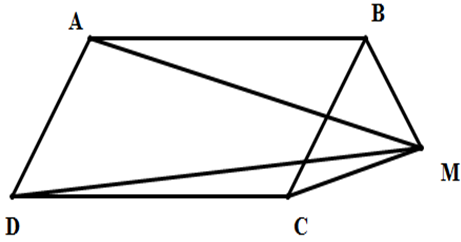Hãy nhập câu hỏi của bạn vào đây, nếu là tài khoản VIP, bạn sẽ được ưu tiên trả lời.

\(\overrightarrow{MA}+\overrightarrow{MB}-\overrightarrow{MC}=\overrightarrow{0}\)
\(\Leftrightarrow\overrightarrow{MA}-\overrightarrow{MC}=-\overrightarrow{MB}\Leftrightarrow\overrightarrow{CA}=\overrightarrow{BM}\)
Vậy M là điểm sao cho tứ giác ACBM là hình bình hành.

Do là giao điểm của hai đường chéo hình bình hành nên:
\(\overrightarrow{MA}+\overrightarrow{MB}+\overrightarrow{MC}+\overrightarrow{MD}\)\(=\overrightarrow{MO}+\overrightarrow{OA}+\overrightarrow{MO}+\overrightarrow{OB}+\overrightarrow{MO}+\overrightarrow{OC}+\overrightarrow{MO}+\overrightarrow{OD}\)
\(=4\overrightarrow{MO}+\overrightarrow{OA}+\overrightarrow{OB}+\overrightarrow{OC}+\overrightarrow{OD}\)
\(=4\overrightarrow{MO}\) (ĐPCM).

Gọi O là tâm bình hành
\(\overrightarrow{MA}+2\overrightarrow{MB}+2\overrightarrow{MC}+\overrightarrow{MD}=\overrightarrow{0}\Leftrightarrow6\overrightarrow{MO}+\overrightarrow{OA}+2\overrightarrow{OB}+2\overrightarrow{OC}+\overrightarrow{OD}=\overrightarrow{0}\)
Dễ dàng nhìn ra trong hình bình hành ABCD tâm O thì: \(\hept{\begin{cases}\overrightarrow{OA}+\overrightarrow{OD}=-\frac{1}{2}\overrightarrow{AB}\\\overrightarrow{OB}+\overrightarrow{OD}=\frac{1}{2}\overrightarrow{AB}\end{cases}}\)--->thế lên trên:
\(\Rightarrow6\overrightarrow{MO}-\frac{1}{2}\overrightarrow{AB}+\overrightarrow{AB}=\overrightarrow{0}\Leftrightarrow\overrightarrow{OM}=\frac{1}{12}\overrightarrow{AB}\)---> Dễ dàng có được M là điểm cố định (Vì các điểm O,A,B đều cố định)
Vậy điểm M được xác định bằng cách lấy đường thẳng qua O song song AB rồi trong nửa mặt phẳng bờ là BD có chứa điểm C ta lấy điểm M thuộc đường thẳng vừa dựng được sao cho đoạn OM có độ dài đúng bằng 1/12 độ dài AB.
Gọi O là giao điểm hai đoạn thẳng AC và BD.
Dựng điểm M như sau:
Trên nửa mặt phẳng bờ AC phía B, vẽ tia Ot song song AB.
Trên tia này, Bạn lấy điểm M cách O một đoạn bằng MỘT PHẦN SÁU AB.
Đó là điểm cần tìm.

Cách 1:
Do ABCD là hình bình hành nên \(\overrightarrow {AB} = \overrightarrow {DC} \)
\(\begin{array}{l} \Rightarrow \overrightarrow {AM} + \overrightarrow {MB} = \overrightarrow {DM} + \overrightarrow {MC} \\ \Leftrightarrow - \overrightarrow {MA} + \overrightarrow {MB} = - \overrightarrow {MD} + \overrightarrow {MC} \\ \Leftrightarrow \overrightarrow {MA} + \overrightarrow {MC} = \overrightarrow {MB} + \overrightarrow {MD} \end{array}\)
Cách 2:
Ta có: \(\overrightarrow {MA} + \overrightarrow {MC} = \overrightarrow {MB} + \overrightarrow {MD} \Leftrightarrow \overrightarrow {MA} - \overrightarrow {MB} = \overrightarrow {MD} - \overrightarrow {MC} \) (*)
Áp dụng quy tắc hiệu ta có: \(\overrightarrow {MA} - \overrightarrow {MB} = \overrightarrow {BA} ;\;\;\overrightarrow {MD} - \overrightarrow {MC} = \overrightarrow {CD} \)
Do đó (*) \( \Leftrightarrow \overrightarrow {BA} = \overrightarrow {CD} \) (luôn đúng do ABCD là hình bình hành)
Cách 3:
Ta có:
\(\overrightarrow {MA} + \overrightarrow {MC} = \overrightarrow {MB} + \overrightarrow {BA} + \overrightarrow {MD} + \overrightarrow {DC} = \overrightarrow {MB} + \overrightarrow {MD} + \left( {\overrightarrow {BA} + \overrightarrow {DC} } \right)\)
Vì ABCD là hình bình hành nên \(\overrightarrow {AB} = \overrightarrow {DC} \)\( \Rightarrow - \overrightarrow {BA} = \overrightarrow {DC} \) hay \(\overrightarrow {BA} + \overrightarrow {DC} = \overrightarrow 0 \)
\( \Rightarrow \overrightarrow {MA} + \overrightarrow {MC} = \overrightarrow {MB} + \overrightarrow {MD} \) (đpcm)
